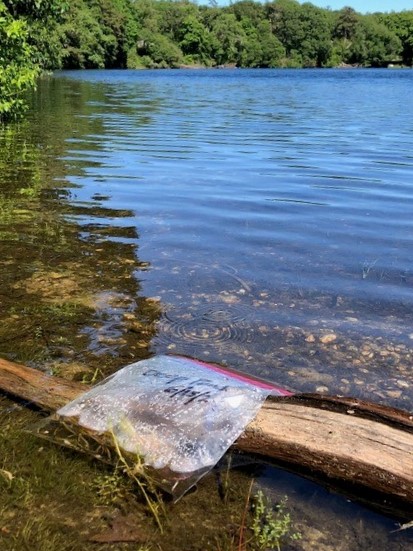by Susan Baur
Several years ago, Falmouth residents who swam in local ponds began to notice a small army of feathery weeds moving in. At first, they were novelties. One popped small white flowers above the pond surface in August. Another created underwater patches of electric blue dots the size of peppercorns. And a third looked like an underwater bottle brush. No one took much notice until it became clear that several of these were growing like crazy and covering over the other pond plants. Rumors, of what the invaders might be, spread faster than the plants themselves. Possibly the dreaded Eurasian milfoil that can grow sixty feet and choke a pond or lake? Or the brilliant green fanwort released in New England from aquariums? But no one knew for sure. Until these plants were identified, plans to control them couldn’t even begin.
On June 16 of this year, Jim Straub and his assistant from the Massachusetts Department of Conservation and Recreation Lakes and Ponds Program came to Falmouth (as earlier they had visited Brewster) to teach us how to identify underwater plants. In coolers and plastic bags, we brought the mystery plants from our ponds and held our collective breath. Once we had learned the basics, it took only a few minutes to zero in on the names.
Some faces lit up with relief. Although the bottle brush plant (low water milfoil) is a fast grower and will spread all over a pond, it won’t grow high and make swimming and boating a problem. It provides food and cover for many pond dwellers. But other residents were horrified. The fanwort, with its little white flowers that is choking Cedar Lake, isn’t going to subside, even if all the septic systems and lawns fertilizers were stopped. It’s feeding off the rich nutrients blanketing the bottom. And the little purple bog buttons or pipewort? You’re lucky if you have that delicate native beauty in your pond!
Happy or sad, it was great to have answers. If you have a question or want a workshop for your town, get in touch with Jim Straub at www.mass.gov/lakesandponds. His advice? Send him a picture of the plant. If possible, put it in a white bowl with water and then take your photo. With a clear idea of what is growing in our ponds, we will be able to take the next steps to keep them healthy and beautiful.
For more ideas about how to save your pond, go to State of the Waters Action Plan.
And remember, always check with your local conservation office before undertaking any projects around a pond so that you don’t run afoul of local and state wetlands protection regulations.
Pond Stories are a collection of writings and other media from Cape Codders and visitors who love the almost 1,000 local ponds that dot the Cape. We hope this collection of stories awakens your inner environmentalist to think deeper about our human impacts to these unique bodies of water.
Send us your favorite pond photo, story, poem, video, artwork–we want to share with everyone why the Cape’s ponds and lakes are so special! Email your pond connection to [email protected]


